How Can We Achieve Carbon Neutrality During Urban Expansion? An Empirical Study from Qionglai City, China
Abstract
1. Introduction
2. Materials and Methods
2.1. Study Area and Data
2.1.1. Overview of the Study Area

2.1.2. Data Sources and Processing
2.2. Methodology
2.2.1. Urban Spatial Expansion Simulation Using the PLUS Model
Development of a Driver Indicator System for Urban Expansion
Simulation of Urban Expansion Using the PLUS Model
2.2.2. Spatial Simulation of Carbon Emissions from TSFs
Carbon Emission Inventory of TSFs
Accounting for Total Carbon Emissions and Coefficient Calculation of TSFs
Calculation of Carbon Emissions for Territorial Spatial Units
Spatial Distribution Forecast of Carbon Emissions by TSFs
2.2.3. Zero-Emission Pathway Design for Urban Expansion Based on Scenario Analysis
Identification of Key Drivers Influencing Carbon Emissions from Urban Expansion
Scenario-Based Design of Carbon-Neutral Pathways for Urban Expansion
3. Results and Analysis
3.1. Simulation Results and Analysis of Urban Space Expansion
3.1.1. Characteristics of the Quantitative Structure of Urban Expansion
3.1.2. Spatial Distribution Characteristics of Urban Expansion
3.2. Simulation Results and Analysis of Carbon Emission Distribution in Territorial Space
3.2.1. Temporal Characteristics of Carbon Emissions from TSFs
3.2.2. Spatial Characteristics of Carbon Emissions from TSFs
Analysis of Historical Spatial Variations
Analysis of Future Spatial Evolution Trends
3.3. Identification and Analysis of Factors Influencing Carbon Emissions from Urban Expansion
3.3.1. Selection of Influencing Factors
3.3.2. Exploring the Driving Factors of Carbon Emissions During Urban Expansion Using the GTWR Model
3.4. Analysis of Zero-Emission Pathways for Urban Expansion
3.4.1. Analysis of Carbon Emission Control Pathways for Urban Expansion Scenarios Under Historical Evolution Patterns
3.4.2. Analysis of Carbon Emission Control Pathways for Urban Expansion Scenarios Under Carbon Neutrality Targets
3.4.3. Designing Zero-Emission Paths for Urban Expansion Under Different Scenarios
4. Discussion
4.1. Integrated Analysis of Urban Expansion Impacts on Carbon Emissions and Carbon Sequestration
4.2. Integrated Effects of Urban Expansion on Carbon Emissions and Storage
4.3. Pathways and Strategies for Achieving Carbon Neutrality in Urban Expansion Scenarios
4.4. Limitations and Future Prospects
5. Conclusions
Supplementary Materials
Author Contributions
Funding
Data Availability Statement
Conflicts of Interest
References
- Intergovernmental Panel on Climate Change (IPCC). Climate Change 2021—The Physical Science Basis; Cambridge University Press: Cambridge, UK, 2023. [Google Scholar] [CrossRef]
- Friedlingstein, P.; Jones, M.W.; O’Sullivan, M.; Andrew, R.M.; Bakker, D.C.; Hauck, J.; Le Quéré, C.; Zeng, J. Global carbon budget 2021. Earth Syst. Sci. Data 2022, 14, 1917–2005. [Google Scholar] [CrossRef]
- Wang, W.-Z.; Liu, L.-C.; Liao, H.; Wei, Y.-M. Impacts of urbanization on carbon emissions: An empirical analysis from OECD countries. Energy Policy 2021, 151, 112171. [Google Scholar] [CrossRef]
- Sun, W.; Huang, C. How does urbanization affect carbon emission efficiency? Evidence from China. J. Clean. Prod. 2020, 272, 122828. [Google Scholar] [CrossRef]
- Zhou, X.; Liang, Y.; Li, L.; Chai, D.; Gu, X.; Yang, L.; Duan, J. Analysis of spatial and temporal characteristics and influence mechanisms of carbon emissions in China, 1997–2017. J. Clean. Prod. 2024, 485, 144411. [Google Scholar] [CrossRef]
- Chen, S.; Long, H.; Fath, B.D.; Chen, B. Global urban carbon networks: Linking inventory to modeling. Environ. Sci. Technol. 2020, 54, 5790–5801. [Google Scholar] [CrossRef]
- Fu, B.; Liu, Y.; Li, Y.; Wang, C.; Li, C.; Jiang, W.; Zhao, W. The research priorities of resources and environmental sciences. Geogr. Sustain. 2021, 2, 87–94. [Google Scholar] [CrossRef]
- Liu, Y.; Yan, B.; Zhou, Y. Urbanization, economic growth, and carbon dioxide emissions in China: A panel cointegration and causality analysis. J. Geogr. Sci. 2016, 26, 131–152. [Google Scholar] [CrossRef]
- Wang, Q.; Su, M. The effects of urbanization and industrialization on decoupling economic growth from carbon emission—A case study of China. Sustain. Cities Soc. 2019, 51, 101758. [Google Scholar] [CrossRef]
- Wang, L.; Jia, Y.; Li, X.; Gong, P. Analyzing the driving forces and environmental effects of urban expansion by mapping the speed and acceleration of built-up areas in China between 1978 and 2017. Remote Sens. 2020, 12, 3929. [Google Scholar] [CrossRef]
- Liu, X.; Li, Y.; Zhang, S.; Niu, Q. Spatiotemporal patterns, driving mechanism, and multi-scenario simulation of urban expansion in Min Delta Region, China. Ecol. Indic. 2024, 158, 111312. [Google Scholar] [CrossRef]
- Xu, T.; Gao, J.; Coco, G. Simulation of urban expansion via integrating artificial neural network with Markov chain–cellular automata. Int. J. Geogr. Inf. Sci. 2019, 33, 1960–1983. [Google Scholar] [CrossRef]
- Wang, Q.; Guan, Q.; Sun, Y.; Du, Q.; Xiao, X.; Luo, H.; Zhang, J.; Mi, J. Simulation of future land use/cover change (LUCC) in typical watersheds of arid regions under multiple scenarios. J. Environ. Manag. 2023, 335, 117543. [Google Scholar] [CrossRef] [PubMed]
- Liang, X.; Guan, Q.; Clarke, K.C.; Liu, S.; Wang, B.; Yao, Y. Understanding the drivers of sustainable land expansion using a patch-generating land use simulation (PLUS) model: A case study in Wuhan, China. Comput. Environ. Urban Syst. 2021, 85, 101569. [Google Scholar] [CrossRef]
- Li, X.; Fu, J.; Jiang, D.; Lin, G.; Cao, C. Land use optimization in Ningbo City with a coupled GA and PLUS model. J. Clean. Prod. 2022, 375, 134004. [Google Scholar] [CrossRef]
- Harris, S.; Weinzettel, J.; Bigano, A.; Källmén, A. Low carbon cities in 2050? GHG emissions of European cities using production-based and consumption-based emission accounting methods. J. Clean. Prod. 2020, 248, 119206. [Google Scholar] [CrossRef]
- Wei, W.; Zhang, P.; Yao, M.; Xue, M.; Miao, J.; Liu, B.; Wang, F. Multi-scope electricity-related carbon emissions accounting: A case study of Shanghai. J. Clean. Prod. 2020, 252, 119789. [Google Scholar] [CrossRef]
- Cui, Y.; Li, L.; Chen, L.; Zhang, Y.; Cheng, L.; Zhou, X.; Yang, X. Land-use carbon emissions estimation for the Yangtze River Delta urban agglomeration using 1994–2016 Landsat image data. Remote Sens. 2018, 10, 1334. [Google Scholar] [CrossRef]
- Rong, T.; Zhang, P.; Jing, W.; Zhang, Y.; Li, Y.; Yang, D.; Yang, J.; Chang, H.; Ge, L. Carbon dioxide emissions and their driving forces of land use change based on economic contributive coefficient (ECC) and ecological support coefficient (ESC) in the Lower Yellow River Region (1995–2018). Energies 2020, 13, 2600. [Google Scholar] [CrossRef]
- Wu, F.; Huang, N.; Zhang, F.; Niu, L.; Zhang, Y. Analysis of the carbon emission reduction potential of China’s key industries under the IPCC 2 °C and 1.5 °C limits. Technol. Forecast. Soc. Change 2020, 159, 120198. [Google Scholar] [CrossRef]
- Fattah, M.A.; Morshed, S.R.; Morshed, S.Y. Impacts of land use-based carbon emission pattern on surface temperature dynamics: Experience from the urban and suburban areas of Khulna, Bangladesh. Remote Sens. Appl. Soc. Environ. 2021, 22, 100508. [Google Scholar] [CrossRef]
- Yang, Y.; Li, H. Monitoring spatiotemporal characteristics of land-use carbon emissions and their driving mechanisms in the Yellow River Delta: A grid-scale analysis. Environ. Res. 2022, 214, 114151. [Google Scholar] [CrossRef]
- Yang, Y.; Yan, F.; Yang, Y.; Chen, Y. Evaluating provincial carbon emission characteristics under China’s carbon peaking and carbon neutrality goals. Ecol. Indic. 2023, 156, 111146. [Google Scholar] [CrossRef]
- Wang, M.; Wang, Y.; Wu, Y.; Yue, X.; Wang, M.; Hu, P. Identifying the spatial heterogeneity in the effects of the construction land scale on carbon emissions: Case study of the Yangtze River Economic Belt, China. Environ. Res. 2022, 212, 113397. [Google Scholar] [CrossRef] [PubMed]
- Liu, J.; Li, M.; Ding, Y. Econometric analysis of the impact of the urban population size on carbon dioxide (CO2) emissions in China. Environ. Dev. Sustain. 2021, 23, 18186–18203. [Google Scholar] [CrossRef]
- Hu, J.; Yan, D.; Wang, W. Estimating carbon stock change caused by multi-scenario land-use structure in Urban Agglomeration. Sustainability 2023, 15, 5503. [Google Scholar] [CrossRef]
- Tian, S.; Wang, S.; Bai, X.; Luo, G.; Li, Q.; Yang, Y.; Deng, Y. Global patterns and changes of carbon emissions from land use during 1992–2015. Environ. Sci. Ecotechnol. 2021, 7, 100108. [Google Scholar] [CrossRef]
- Anser, M.K.; Syed, Q.R.; Apergis, N. Does geopolitical risk escalate CO2 emissions? Evidence from the BRICS countries. Environ. Sci. Pollut. Res. 2021, 28, 48011–48021. [Google Scholar] [CrossRef]
- Li, J.; Liu, A. Impact of urbanization on total factor carbon productivity in Central Asia. Sustainability 2022, 14, 15379. [Google Scholar] [CrossRef]
- Ma, W.; Liu, K.; Li, Y.; Zhang, H. The impact of FDI quality characteristics on carbon emission intensity: Evidence from China. Front. Environ. Sci. 2022, 10, 998915. [Google Scholar] [CrossRef]
- Cui, E.; Ren, L.; Sun, H. Analysis of energy-related CO2 emissions and driving factors in five major energy consumption sectors in China. Environ. Sci. Pollut. Res. 2016, 23, 19667–19674. [Google Scholar] [CrossRef]
- Huang, Z.X.; Yang, X. Carbon emissions and firm innovation. Econ. Anal. Policy 2021, 69, 503–513. [Google Scholar] [CrossRef]
- Cui, Y.; Khan, S.U.; Deng, Y.; Zhao, M. Spatiotemporal heterogeneity, convergence and its impact factors: Perspective of carbon emission intensity and carbon emission per capita considering carbon sink effect. Environ. Impact Assess. Rev. 2022, 92, 106699. [Google Scholar] [CrossRef]
- Chen, H.; Qi, S.; Tan, X. Decomposition and prediction of China’s carbon emission intensity towards carbon neutrality: From perspectives of national, regional and sectoral level. Sci. Total Environ. 2022, 825, 153839. [Google Scholar] [CrossRef] [PubMed]
- Yan, M.; Sun, H.; Gu, K. Driving factors and key emission reduction paths of Xinjiang industries carbon emissions: An industry chain perspective. J. Clean. Prod. 2022, 374, 133879. [Google Scholar] [CrossRef]
- Liang, S.; Kong, Y.; Zou, M.; Peng, Y. Spatial heterogeneity-based drivers of carbon emissions in the Pearl River Delta. Acta Sci. Circumstantiae 2023, 43, 237–244. [Google Scholar] [CrossRef]
- Quan, C.; Cheng, X.; Yu, S.; Ye, X. Analysis on the influencing factors of carbon emission in China’s logistics industry based on LMDI method. Sci. Total Environ. 2020, 734, 138473. [Google Scholar] [CrossRef]
- He, J.; Yang, J. Spatial-temporal characteristics and influencing factors of land-use carbon emissions: An empirical analysis based on the GTWR model. Land 2023, 12, 1506. [Google Scholar] [CrossRef]
- Wang, Y.; Niu, Y.; Li, M.; Yu, Q.; Chen, W. Spatial structure and carbon emission of urban agglomerations: Spatiotemporal characteristics and driving forces. Sustain. Cities Soc. 2022, 78, 103600. [Google Scholar] [CrossRef]
- Shi, F.; Liao, X.; Shen, L.; Meng, C.; Lai, Y. Exploring the spatiotemporal impacts of urban form on CO2 emissions: Evidence and implications from 256 Chinese cities. Environ. Impact Assess. Rev. 2022, 96, 106850. [Google Scholar] [CrossRef]
- Meng, W.; Linlin, W.; Jin, C. Territorial carbon sink conflict measurement and its spatial pattern in theYangtze River Delta urban agglomeration. Resour. Sci. 2022, 44, 2048–2059. [Google Scholar] [CrossRef]
- Vasenev, V.I.; Stoorvogel, J.J.; Dolgikh, A.V.; Ananyeva, N.D.; Ivashchenko, K.V.; Valentini, R. Changes in soil organic carbon stocks by urbanization. In Urban Soils; CRC: Boca Raton, FL, USA, 2017; pp. 61–92. [Google Scholar]
- Sikder, M.; Wang, C.; Yao, X.; Huai, X.; Wu, L.; Kwame Yeboah, F.; Dou, X. The integrated impact of GDP growth, industrialization, energy use, and urbanization on CO2 emissions in developing countries: Evidence from the panel ARDL approach. Sci. Total Environ. 2022, 837, 155795. [Google Scholar] [CrossRef] [PubMed]
- Liu, Z.; Deng, Z.; He, G.; Wang, H.; Zhang, X.; Lin, J.; Liang, X. Challenges and opportunities for carbon neutrality in China. Nat. Rev. Earth Environ. 2022, 3, 141–155. [Google Scholar] [CrossRef]
- Li, X.; Zheng, Z.; Shi, D.; Han, X.; Zhao, M. New urbanization and carbon emissions intensity reduction: Mechanisms and spatial spillover effects. Sci. Total Environ. 2023, 905, 167172. [Google Scholar] [CrossRef] [PubMed]
- Dong, L.; Wang, Y.; Ai, L.; Cheng, X.; Luo, Y. A review of research methods for accounting urban green space carbon sinks and exploration of new approaches. Front. Environ. Sci. 2024, 12, 1350185. [Google Scholar] [CrossRef]
- Wu, S.; Hu, S.; Frazier, A.E.; Hu, Z. China’s urban and rural residential carbon emissions: Past and future scenarios. Resour. Conserv. Recycl. 2023, 190, 106802. [Google Scholar] [CrossRef]
- Qin, J.; Ou, D.; Yang, Z.; Gao, X.; Zhong, Y.; Yang, W.; Deng, O. Synergizing economic growth and carbon emission reduction in China: A path to coupling the MFLP and PLUS models for optimizing the territorial spatial functional pattern. Sci. Total Environ. 2024, 929, 171926. [Google Scholar] [CrossRef]
- Ou, D.; Zhang, Q.; Qin, J.; Gong, S.Q.; Wu, Y.J.; Zheng, Z.S. Classification system for county-level territorial space using spatiotemporal heterogeneity and dynamic coupling of land use and functionality. Trans. Chin. Soc. Agric. Eng. (Trans. CSAE) 2021, 37, 284–296, (In Chinese with English Abstract). [Google Scholar] [CrossRef]
- Intergovernmental Panel on Climate Change. Chapter Energy. In 2006 IPCC Guidelines for National Greenhouse Gas Inventories; Eggleston, S., Buendia, L., Miwa, K., Ngara, T., Tanabe, K., Eds.; Institute for Global Environmental Strategies: Hayama, Japan, 2006; Volume 2. [Google Scholar]
- Intergovernmental Panel on Climate Change. Refinement to the 2006 IPCC Guidelines for National Greenhouse Gas Inventories; IPCC: Geneva, Switzerland, 2019; Volume 4, p. 824. [Google Scholar]
- Liu, T.L.; Song, Q.J.; Lu, J.Q.; Qi, Y. An integrated approach to evaluating the coupling coordination degree between low-carbon development and air quality in Chinese cities. Adv. Clim. Change Res. 2021, 12, 710–722. [Google Scholar] [CrossRef]
- Yang, Y.; Meng, G. Analysis of the decoupling effect and eco-economic coordination of the resident energy carbon footprint: A case study of Caijiapo Town, a national key town in western China. Environ. Sci. Pollut. Res. 2020, 27, 6936–6949. [Google Scholar] [CrossRef]
- Chen, X.; Di, Q.; Jia, W.; Hou, Z. Spatial correlation network of pollution and carbon emission reductions coupled with high-quality economic development in three Chinese urban agglomerations. Sustain. Cities Soc. 2023, 94, 104552. [Google Scholar] [CrossRef]
- Shan, Y.; Guan, D.; Liu, J.; Mi, Z.; Liu, Z.; Liu, J.; Zhang, Q. Methodology and applications of city level CO2 emission accounts in China. J. Clean. Prod. 2017, 161, 1215–1225. [Google Scholar] [CrossRef]
- Zhang, H.; Xu, L.; Zhou, P.; Zhu, X.; Cudjoe, D. Coordination between economic growth and carbon emissions: Evidence from 178 cities in China. Econ. Anal. Policy 2024, 81, 164–180. [Google Scholar] [CrossRef]
- Nor, A.N.; Corstanje, R.; Harris, J.A.; Brewer, T. Impact of rapid urban expansion on green space structure. Ecol. Indic. 2017, 81, 274–284. [Google Scholar] [CrossRef]
- Liu, F.; Zhang, Z.; Shi, L.; Zhao, X.; Xu, J.; Yi, L.; Li, M. Urban expansion in China and its spatial-temporal differences over the past four decades. J. Geogr. Sci. 2016, 26, 1477–1496. [Google Scholar] [CrossRef]
- Lin, Z.; Peng, S. Comparison of multimodel simulations of land use and land cover change considering integrated constraints: A case study of the Fuxian Lake basin. Ecol. Indic. 2022, 142, 109254. [Google Scholar] [CrossRef]
- Yokomichi, H.; Masuda, A. Effects of nitrogen incorporation on structural properties of fluorinated amorphous carbon films. J. Non-Cryst. Solids 2000, 271, 147–151. [Google Scholar] [CrossRef]
- Almantariotis, D.; Stevanović, S.; Fandiño, O.; Pensado, A.S.; Pádua, A.A.H.; Coxam, J.-Y.; Costa Gomes, M.F. Absorption of carbon dioxide, nitrous oxide, ethane and nitrogen by 1-alkyl-3-methylimidazolium (Cnmim, n = 2, 4, 6) tris(pentafluoroethyl)trifluorophosphate ionic liquids (eFAP). J. Phys. Chem. B 2012, 116, 7728–7738. [Google Scholar] [CrossRef] [PubMed]
- Hogue, S.; Roten, D.; Marland, E.; Marland, G.; Boden, T.A. Gridded estimates of CO2 emissions: Uncertainty as a function of grid size. Mitig. Adapt. Strateg. Glob. Change 2019, 24, 969–983. [Google Scholar] [CrossRef]
- Tao, J.; Kong, X. Spatial allocation of anthropogenic carbon dioxide emission statistics data fusing multi-source data based on Bayesian network. Sci. Rep. 2021, 11, 18128. [Google Scholar] [CrossRef]
- Wang, C.; Wang, J.; Ma, L.; Jia, M.; Chen, J.; Shao, Z.; Chen, N. Prediction Modeling and Driving Factor Analysis of Spatial Distribution of CO2 Emissions from Urban Land in the Yangtze River Economic Belt, China. Land 2024, 13, 1433. [Google Scholar] [CrossRef]
- Xu, L.; Du, H.; Zhang, X. Driving forces of carbon dioxide emissions in China’s cities: An empirical analysis based on the geodetector method. J. Clean. Prod. 2021, 287, 125169. [Google Scholar] [CrossRef]
- Feng, Y.Y.; Zhang, L.X. Scenario analysis of urban energy saving and carbon abatement policies: A case study of Beijing city, China. Procedia Environ. Sci. 2012, 13, 632–644. [Google Scholar] [CrossRef]
- Tan, X.; Zeng, Y.; Gu, B.; Wang, Y.; Xu, B. Scenario analysis of urban road transportation energy demand and GHG emissions in China—A case study for Chongqing. Sustainability 2018, 10, 2033. [Google Scholar] [CrossRef]
- Wang, Q.; Xiao, Y. Has urban construction land achieved low-carbon sustainable development? A case study of North China Plain, China. Sustainability 2022, 14, 9434. [Google Scholar] [CrossRef]
- Fu, Y.; Wang, Z. The impact of industrial agglomeration on urban carbon emissions: An empirical study based on the panel data of China’s prefecture-level cities. Sustainability 2024, 16, 10270. [Google Scholar] [CrossRef]
- Feng, Y.; Chen, S.; Tong, X.; Lei, Z.; Gao, C.; Wang, J. Modeling changes in China’s 2000–2030 carbon stock caused by land use change. J. Clean. Prod. 2020, 252, 119659. [Google Scholar] [CrossRef]
- Martínez-Zarzoso, I.; Maruotti, A. The impact of urbanization on CO2 emissions: Evidence from developing countries. Ecol. Econ. 2011, 70, 1344–1353. [Google Scholar] [CrossRef]
- Rahman, M.N.; Akter, K.S.; Faridatul, M.I. Assessing the impact of urban expansion on carbon emission. Environ. Sustain. Indic. 2024, 23, 100416. [Google Scholar] [CrossRef]
- Lyu, S.; Huang, Y.; Sun, T. Urban sprawl, public transportation efficiency and carbon emissions. J. Clean. Prod. 2025, 489, 144652. [Google Scholar] [CrossRef]
- Zhang, X.; Brandt, M.; Tong, X.; Ciais, P.; Yue, Y.; Xiao, X.; Fensholt, R. A large but transient carbon sink from urbanization and rural depopulation in China. Nat. Sustain. 2022, 5, 321–328. [Google Scholar] [CrossRef]
- Fan, Y.; Wei, F. Contributions of natural carbon sink capacity and carbon neutrality in the context of net-zero carbon cities: A case study of Hangzhou. Sustainability 2022, 14, 2680. [Google Scholar] [CrossRef]
- Liu, X.; Li, T.; Zhang, S.; Jia, Y.; Li, Y.; Xu, X. The role of land use, construction and road on terrestrial carbon stocks in a newly urbanized area of western Chengdu, China. Landsc. Urban Plan. 2016, 147, 88–95. [Google Scholar] [CrossRef]
- Liu, G.; Zhang, F. How do trade-offs between urban expansion and ecological construction influence CO2 emissions? New evidence from China. Ecol. Indic. 2022, 141, 109070. [Google Scholar] [CrossRef]
- Zhang, Z.; Yu, X.; Hou, Y.; Chen, T.; Lu, Y.; Sun, H. Carbon emission patterns and carbon balance zoning in urban territorial spaces based on multisource data: A case study of Suzhou city, China. ISPRS Int. J. Geo-Inf. 2023, 12, 385. [Google Scholar] [CrossRef]
- Zhuang, Q.; Shao, Z.; Li, D.; Huang, X.; Li, Y.; Altan, O.; Wu, S. Impact of global urban expansion on the terrestrial vegetation carbon sequestration capacity. Sci. Total Environ. 2023, 879, 163074. [Google Scholar] [CrossRef] [PubMed]
- Lu, H.Y.; Qi, J.J.; Ye, Y.L.; Zhang, B.E.; Sun, J.L.; Yang, C.C.; Zhao, M.W. Characteristics of Spatiotemporal Changes in China’s Carbon Budget at Different Administrative Scales. Huan Jing Ke = Xue Huanjing Kexue 2024, 45, 5601–5612. [Google Scholar] [CrossRef] [PubMed]
- Zhao, H.X.; Shi, J.J.; He, R.C.; Ma, C.X. Spatio-temporal heterogeneity of factors influencing transportation carbon emissions in provinces along the Belt and Road. Huan Jing Ke Xue = Huanjing Kexue 2024, 45, 4636–4647. [Google Scholar] [CrossRef] [PubMed]
- Ding, Y.; Xu, L.; Sun, Y.; Wu, Y.; Liu, X.; Geng, X. Large but overlooked carbon differentiations inside China’s provinces matters to mitigation strategies design: Evidence from county-level analysis. Sci. Total Environ. 2023, 898, 165551. [Google Scholar] [CrossRef]
- Li, S.; Xu, Z.; Wang, H. Spatiotemporal characteristics and factors driving exploration of industrial carbon-emission intensity: A case study of Guangdong Province, China. Sustainability 2022, 14, 15064. [Google Scholar] [CrossRef]
- Liu, X.; Wang, P.; Song, H.; Zeng, X. Determinants of net primary productivity: Low-carbon development from the perspective of carbon sequestration. Technol. Forecast. Soc. Change 2021, 172, 121006. [Google Scholar] [CrossRef]
- Gharibi, S.; Shayesteh, K. Quantifying and mapping the supply-demand for carbon sequestration by urban green infrastructures: Evidence from Hamadan Urban Area, Iran. In Environment Development and Sustainability; Springer: Berlin/Heidelberg, Germany, 2024; pp. 1–23. [Google Scholar] [CrossRef]
- Tu, W.; Rao, C.; Xiao, X.; Hu, F.; Goh, M. Interactive geographical and temporal weighted regression to explore spatio-temporal characteristics and drivers of carbon emissions. Environ. Technol. Innov. 2024, 36, 103836. [Google Scholar] [CrossRef]
- Zhuang, Q.; Shao, Z.; Li, D.; Huang, X.; Altan, O.; Wu, S.; Li, Y. Isolating the direct and indirect impacts of urbanization on vegetation carbon sequestration capacity in a large oasis city: Evidence from Urumqi, China. Geo-Spat. Inf. Sci. 2023, 26, 379–391. [Google Scholar] [CrossRef]
- Velasco, E.; Roth, M.; Norford, L.; Molina, L.T. Does urban vegetation enhance carbon sequestration? Landsc. Urban Plan. 2016, 148, 99–107. [Google Scholar] [CrossRef]
- Xi, F.M.; Liang, W.J.; Niu, M.F.; Wang, J.Y. Carbon emissions and low-carbon regulation countermeasures of land use change in the city and town concentrated area of central Liaoning Province, China. J. Appl. Ecol. 2016, 27, 577–584. [Google Scholar]
- Yang, F.; He, F.; Li, S.; Li, M.; Wu, P. A new estimation of carbon emissions from land use and land cover change in China over the past 300 years. Sci. Total Environ. 2023, 863, 160963. [Google Scholar] [CrossRef]
- Li, B.; Fang, X.; Ye, Y.; Zhang, X. Carbon emissions induced by cropland expansion in Northeast China during the past 300 years. Sci. China Earth Sci. 2014, 57, 2259–2268. [Google Scholar] [CrossRef]
- Cheng, W. Study on the optimization of urban traffic and spatial structure in the environment of low-carbon eco-cities. Int. J. Knowl. Manag. 2024, 20, 1–14. [Google Scholar] [CrossRef]
- Yuan, Y.; Xu, P.; Zhang, H. Spatial Zoning of Carbon Dioxide Emissions at the Intra-City Level: A Case Study of Nanjing, China. Int. J. Environ. Res. Public Health 2023, 20, 4023. [Google Scholar] [CrossRef]
- Liu, Z.; Zhong, J.; Liu, Y.; Liang, Y.; Li, Z. Dynamic simulation of street-level carbon emissions in megacities: A case study of Wuhan City, China (2015–2030). Sustain. Cities Soc. 2024, 115, 105853. [Google Scholar] [CrossRef]
- Zhang, Y.; Long, H.; Tu, S.; Ge, D.; Ma, L.; Wang, L. Spatial identification of land use functions and their tradeoffs/synergies in China: Implications for sustainable land management. Ecol. Indic. 2019, 107, 105550. [Google Scholar] [CrossRef]
- Sun, R.; Liu, C.M.; Li, X.W. Estimation of evapotranspiration in the Yellow River Basin using integrated NDVI. J. Nat. Resour. 2003, 18, 155–160. [Google Scholar] [CrossRef]
- Xie, G.; Zhang, C.; Zhang, L.; Chen, W.; Li, S. Improvement of ecosystem service valuation method based on unit area value equivalent factor. J. Nat. Resour. 2015, 30, 1243–1254. [Google Scholar] [CrossRef]
- Ganasri, B.P.; Ramesh, H.J.G.F. Assessment of soil erosion by RUSLE model using remote sensing and GIS-A case study of Nethravathi Basin. Geosci. Front. 2016, 7, 953–961. [Google Scholar] [CrossRef]
- Chu, L.; Sun, T.; Wang, T.; Li, Z.; Cai, C. Evolution and prediction of landscape pattern and habitat quality based on CA-Markov and InVEST model in Hubei section of Three Gorges Reservoir Area (TGRA). Sustainability 2018, 10, 3854. [Google Scholar] [CrossRef]
- Liu, C.; Xu, Y.; Liu, Y.; Sun, P.; Huang, A.; Zhou, J. Research on land use functions classification and evaluation system based on system theory. Acta Sci. Nat. Univ. Pekin. 2018, 54, 181–188. [Google Scholar] [CrossRef]
- Shi, H.; Mu, X.M.; Zhang, Y.; Lu, M.Q. Effects of different land use patterns on carbon emission in Guangyuan City of Sichuan Province. Bull. Soil Water Conserv. 2012, 32, 101–106. [Google Scholar] [CrossRef]
- Tsuruta, H.; Mosier, A. Estimate of CH4 Emissions from Year-Round Flooded Rice Fields During Rice Growing Season in China. Pedosphere 2005, 1, 66–71. [Google Scholar]
- He, Y. Research on Climate and Terrestrial Ecosystem Carbon Cycle in China; China Meteorological Press: Beijing, China, 2006. [Google Scholar]
- Fang, J.Y.; Guo, Z.D.; Piao, S.L.; Chen, A.P. Terrestrial vegetation carbon sinks in China, 1981–2000. Sci. China Ser. D Earth Sci. 2007, 50, 1341–1350. [Google Scholar] [CrossRef]
- Zhao, R.; Huang, X.; Zhong, T.; Chuai, X. Carbon effect evaluation and low-carbon optimization of regional land use. Trans. Chin. Soc. Agric. Eng. 2013, 29, 220–229. [Google Scholar] [CrossRef]
- Duan, X.N.; Wang, X.K.; Lu, F.; Ouyang, Z.Y. Carbon sequestration and its potential by wetland ecosystems in China. Acta Ecol. Sin. 2008, 2, 463–469. [Google Scholar]
- Lai, L. Study on Carbon Emission Effect of Land Use in China. Doctoral Dissertation, Nanjing University, Nanjing, China, 2010. [Google Scholar]
- Zhu, E.; Deng, J.; Zhou, M.; Gan, M.; Jiang, R.; Wang, K.; Shahtahmassebi, A. Carbon emissions induced by land-use and land-cover change from 1970 to 2010 in Zhejiang, China. Sci. Total Environ. 2019, 646, 930–939. [Google Scholar] [CrossRef]
- Zhao, R. Carbon Cycle of Urban Eco-Economic System and Its Regulation Through Land Use Control: A Case Study of Nanjing City. Doctoral Dissertation, Nanjing University, Nanjing, China, 2011. [Google Scholar]
- Zhao, R.; Huang, X.; Peng, B. Research on carbon cycle and carbon balance of Nanjing urban system. Acta Geogr. Sin. 2012, 67, 758–770. [Google Scholar] [CrossRef]
- Fang, J.Y.; Liu, G.H.; Xu, S.L. Carbon Cycle of Terrestrial Ecosystem in China and Its Global Meaning; China Environmental Science Press: Beijing, China, 1996. [Google Scholar]
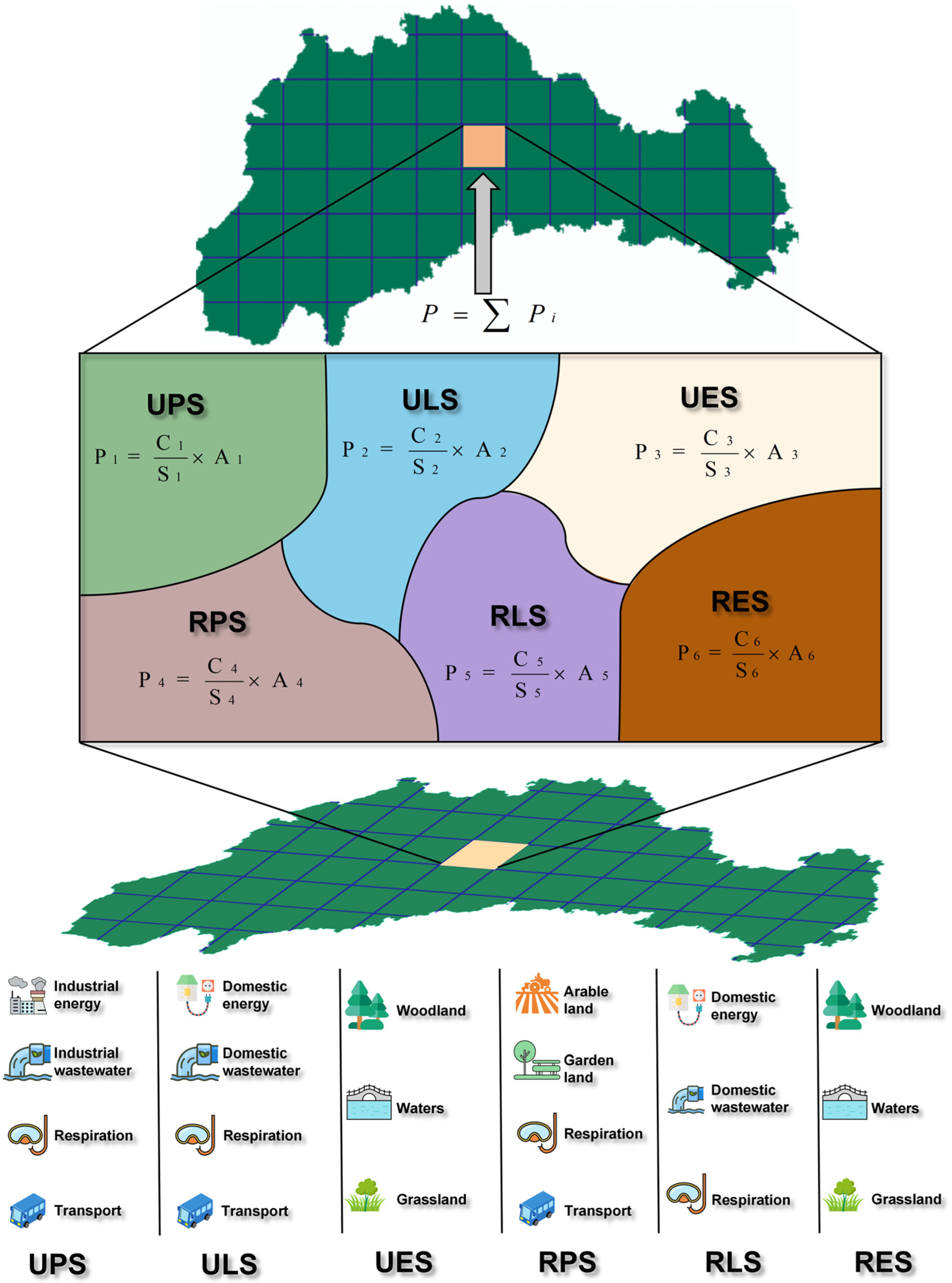
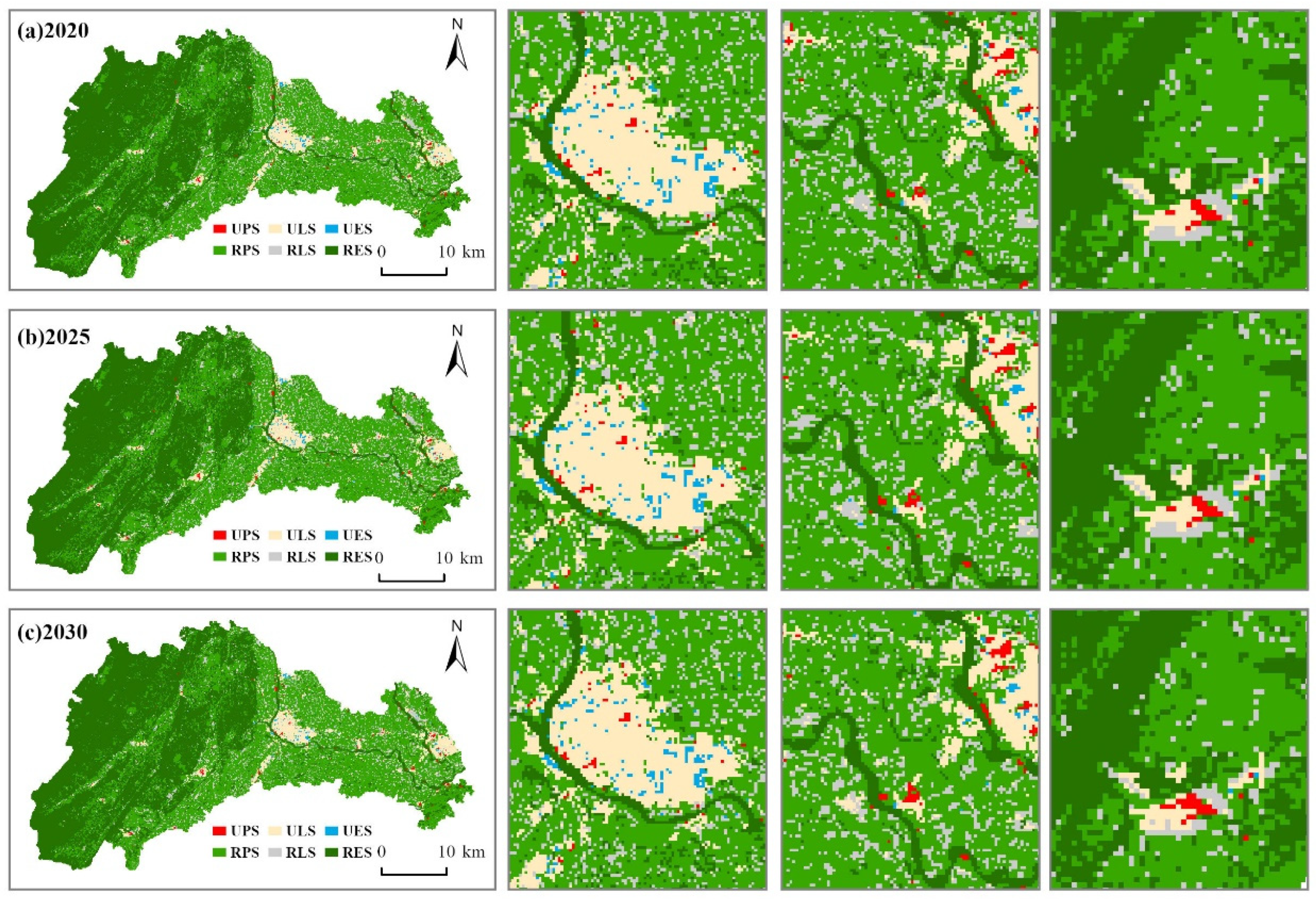
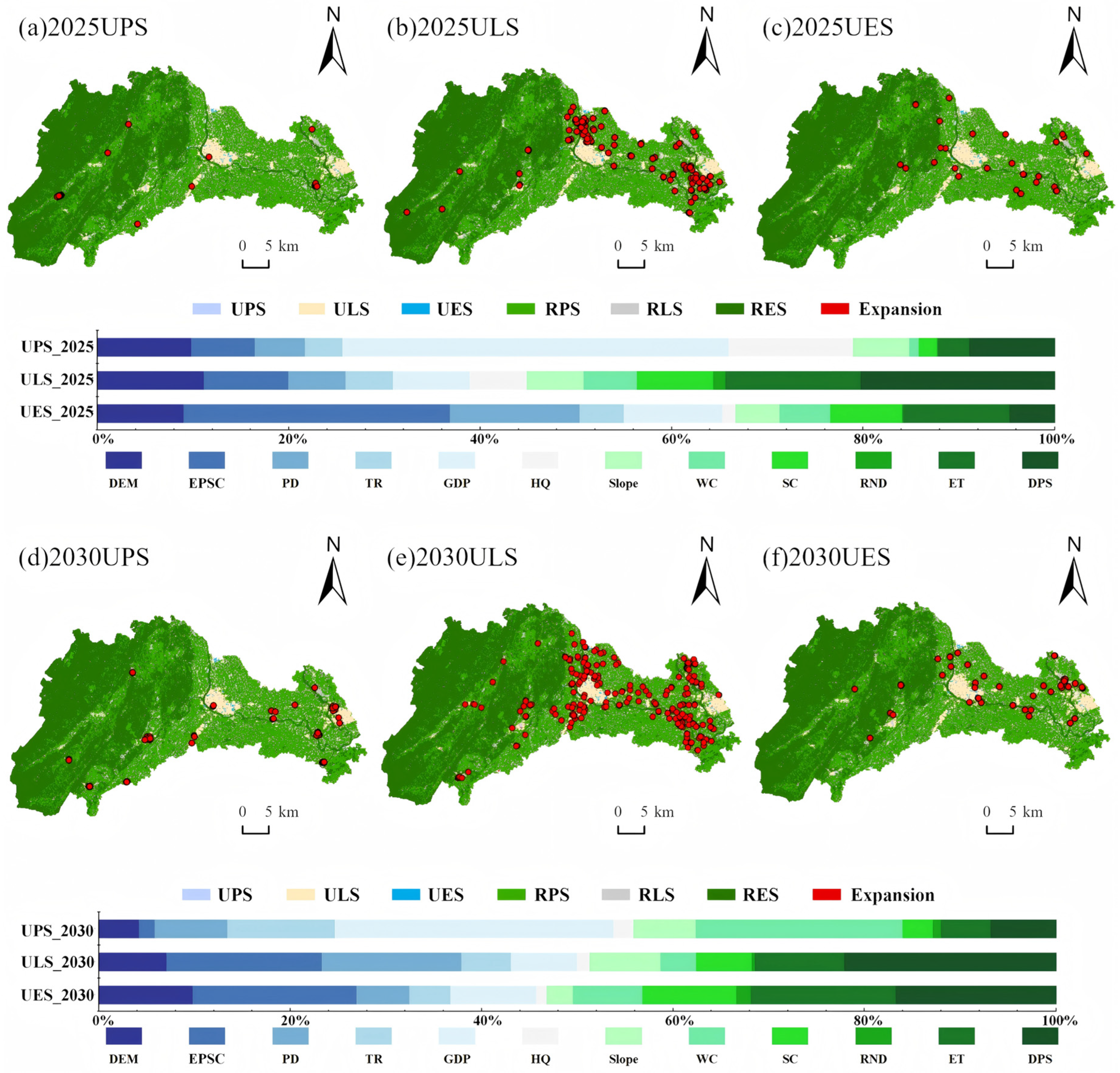
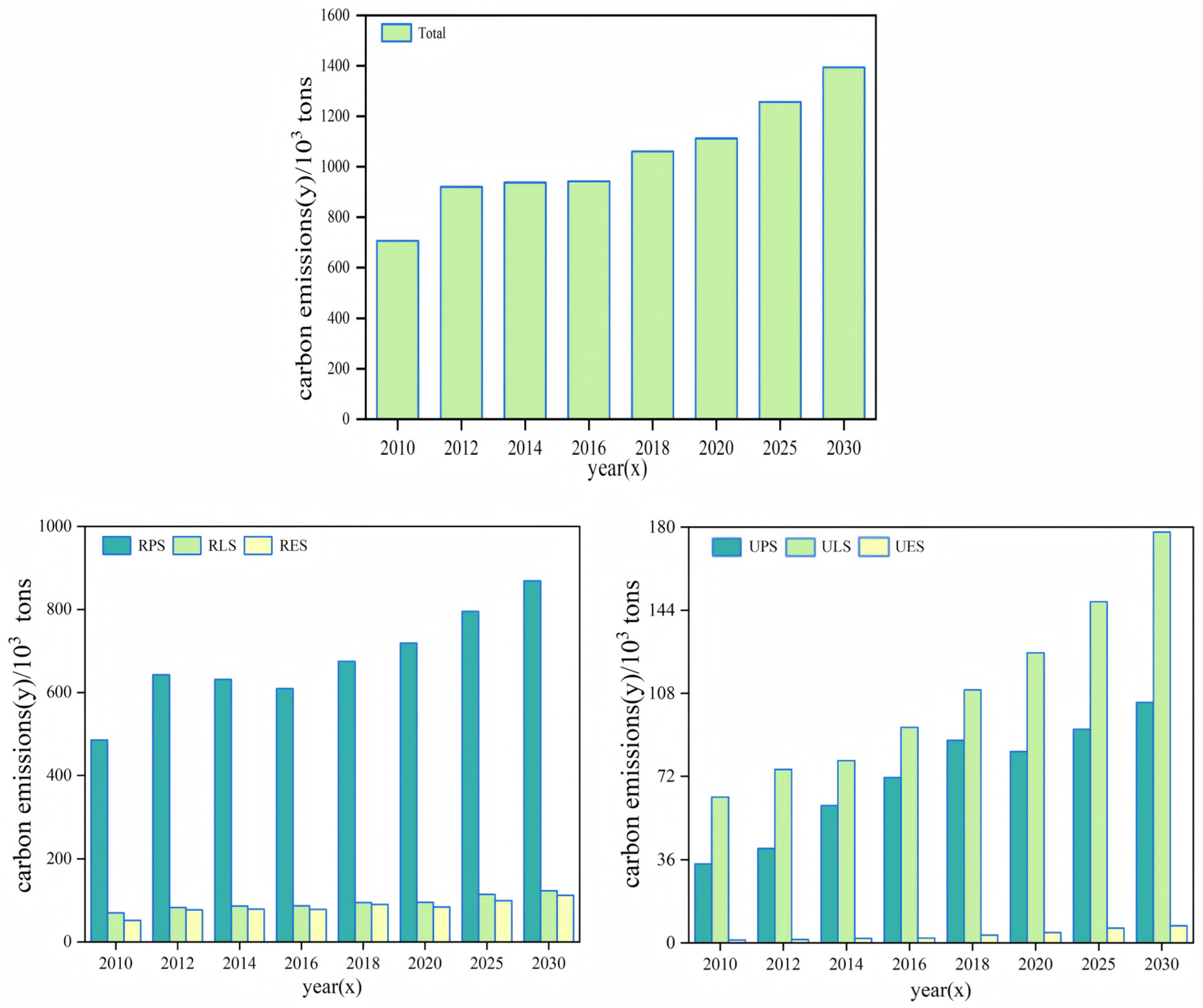
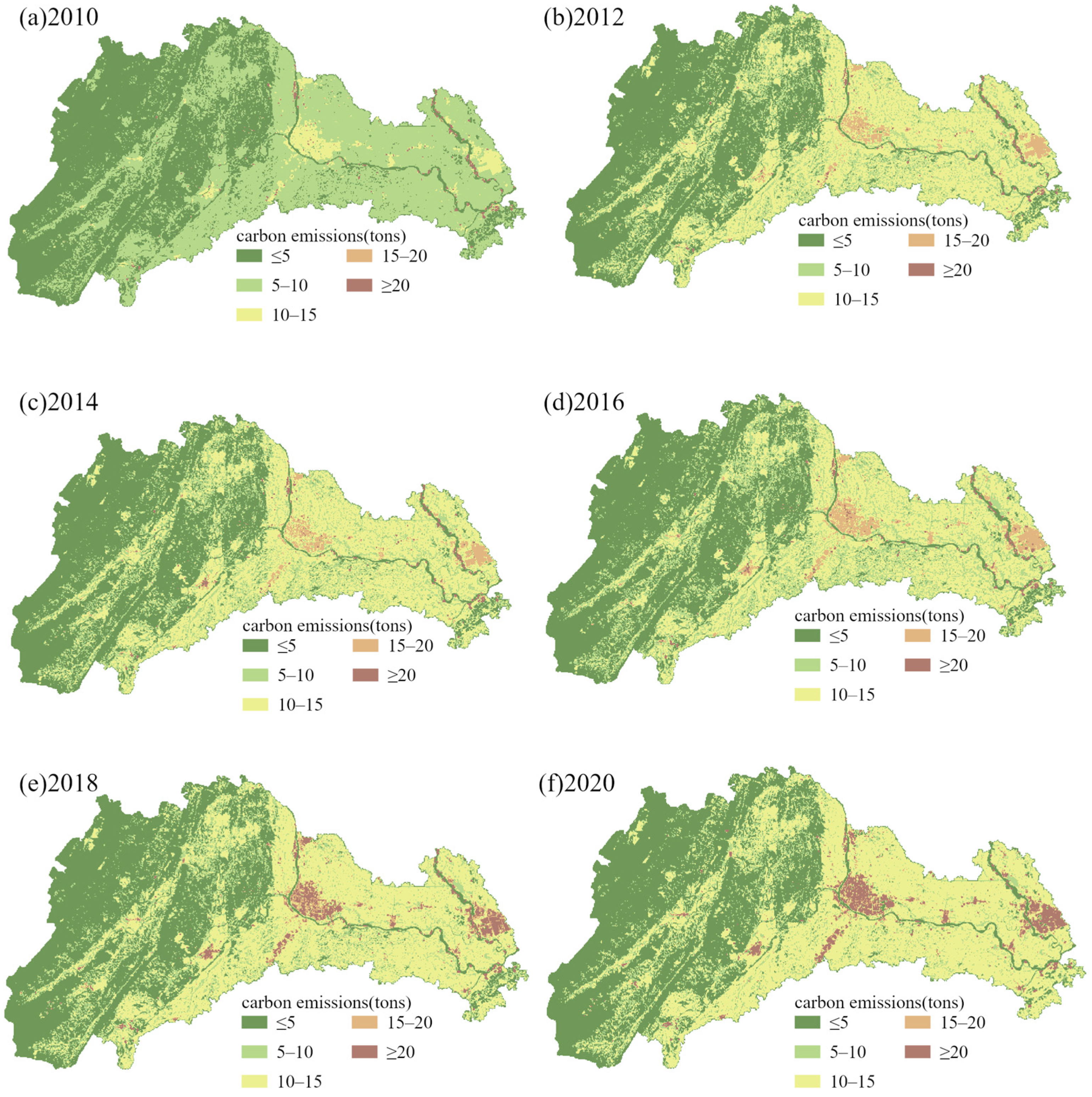

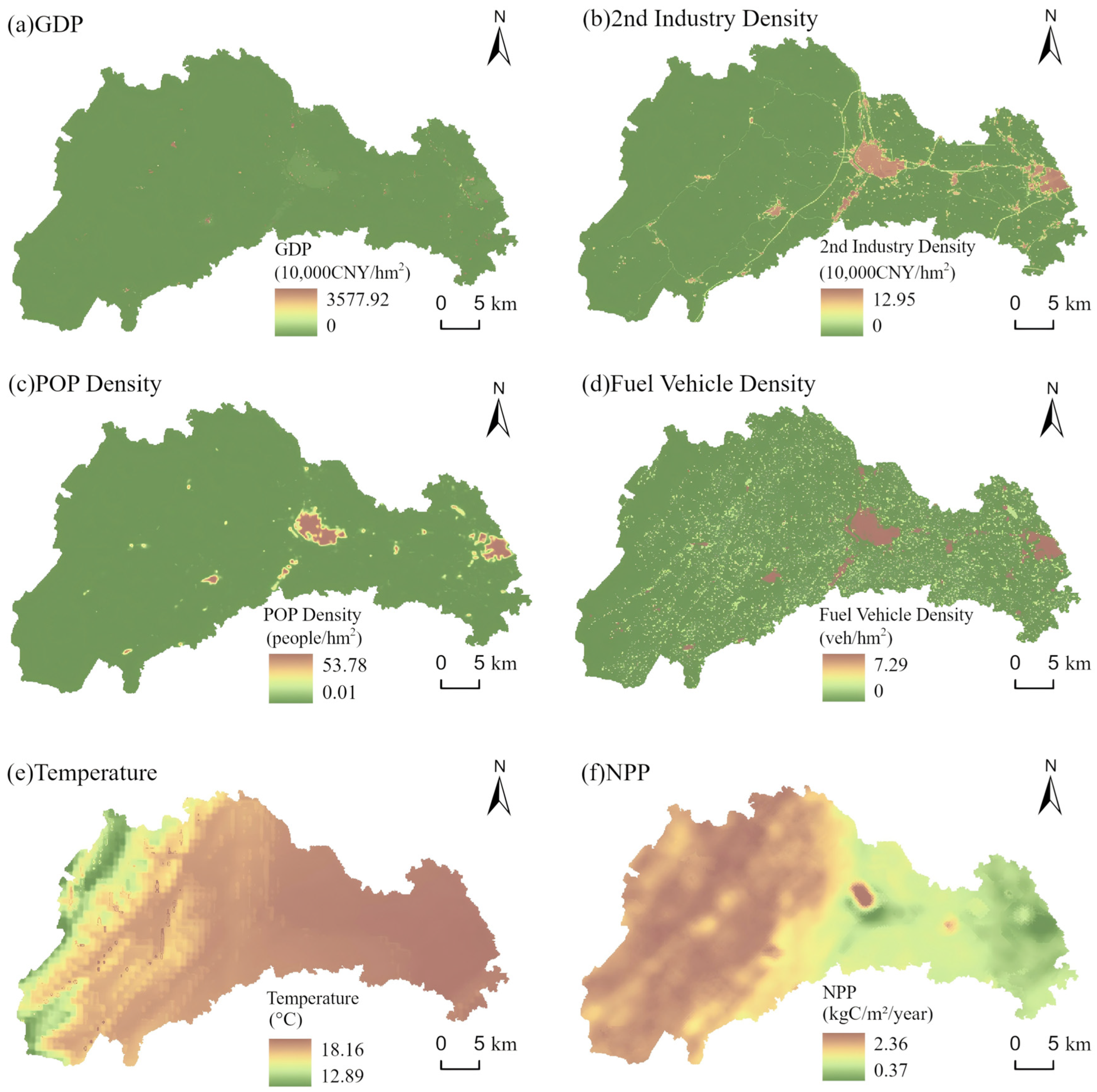

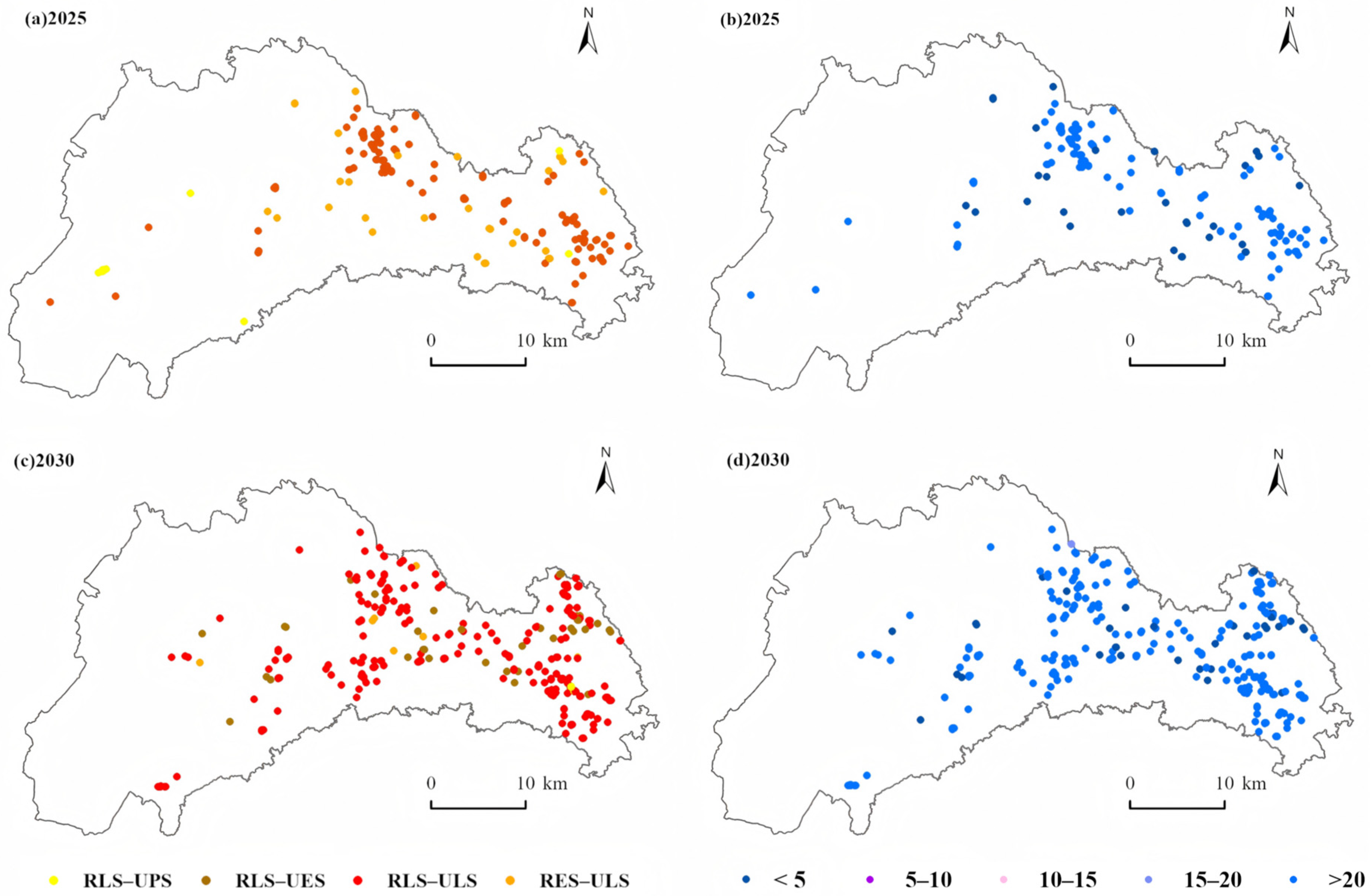
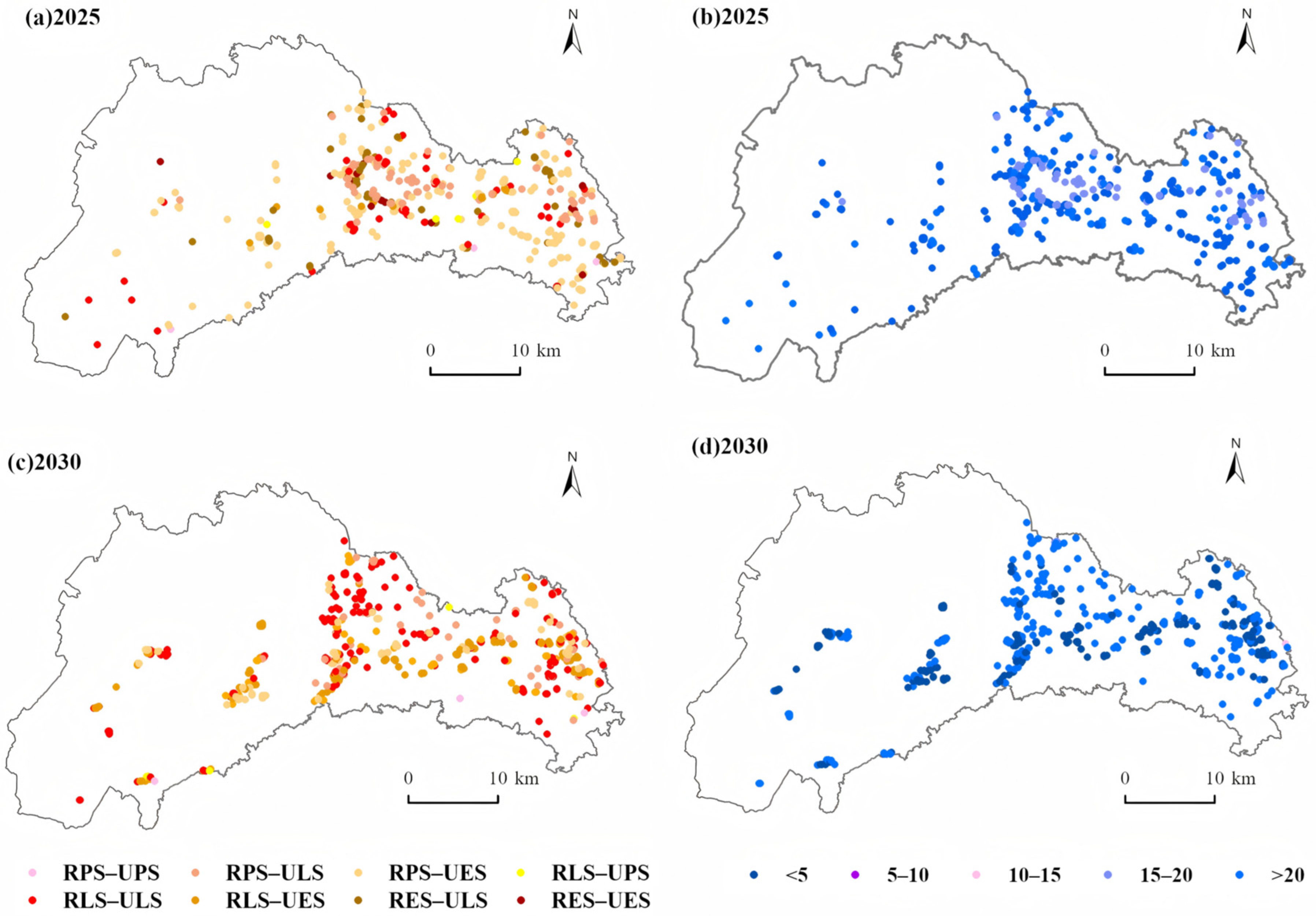
| Data Type | Data Name | Time-Series (Year) | Resolution | Data Source |
|---|---|---|---|---|
| Raster data | DEM | 2020 | 12.5 m | 91 Visitor Assistant |
| Google satellite image | 2020 | 10 m | https://developers.google.com/earth-engine/datasets (accessed on 19 January 2025) | |
| Territorial space–function distribution map | 2009–2023 | 50 m | Previous research datasets [49] | |
| Temperature | 2000–2020 | 1 km | National Tibetan Plateau/Third Pole Environment Data Center http://data.tpdc.ac.cn (accessed on 19 January 2025) | |
| Precipitation | ||||
| Net primary productivity | 2000–2020 | 500 m | National Earth System Science Data Center https://www.geodata.cn/data/index.html?word=NPP (accessed on 19 January 2025) | |
| NDVI | National Earth System Science Data Center https://www.geodata.cn/main/face_scientist?categoryId=&word=NDVI (accessed on 19 January 2025) | |||
| Vector Data | Administrative boundary | 2020 | 1:5000 | Sichuan Academy of Land Science and Technology |
| Land use status data | 2009–2023 | 1:5000 | Sichuan Academy of Land Science and Technology | |
| Road Network Vector Data | - | OpenStreetMap | ||
| Panel data | Number of pigs (head) | 2009–2023 | County level | Qionglai Statistics Bureau |
| Number of cows (head) | ||||
| Number of sheep (head) | ||||
| Urban population (person) | Township-level | |||
| Rural population (person) | ||||
| GDP per capita (104 CNY/person) | ||||
| Energyconsumption per 104 CNY of industrial output (tce/104 CNY) | 2009–2023 | City-level | Chengdu Municipal Bureau of Statistics | |
| Per capita electricity consumption (kWh/person) | ||||
| Per capita natural gas consumption (m3/person) | ||||
| Per capita liquefied gas consumption (kg/person) | ||||
| Chemical oxygen demand (COD) in wastewater (t) | 2009–2023 | Provincial-level | China Energy Statistical Yearbook |
| Driving Factor | Measurement Indicators | Description | Unit |
|---|---|---|---|
| Topography and Landform | Elevation | Vertical height of a surface point relative to the mean sea level. | m |
| Slope | Ratio of vertical rise to horizontal distance on the land surface. | % | |
| Topographic relief | Maximum relative elevation difference per unit area. | m/km2 | |
| Natural Environment | Water conservation | The ecosystem’s ability to purify, store, and supply freshwater. | m3/raster |
| Evapotranspiration | Total volume of water released into the atmosphere through plant transpiration. | m3/d | |
| Environmental purification service capacity | The ecosystem’s self-purification capacity for water and air. | - | |
| Soil conservation | Index of the ecosystem’s ability to control erosion and maintain nutrient cycling. | - | |
| Habitat quality | Composite index for biodiversity maintenance and ecological sustainability. | - | |
| Transportation Location | Road network density | Ratio of total road length to the area of the evaluation unit. | km/km2 |
| Distance to public services | Shortest feasible distance to key public service facilities (e.g., education, healthcare). | m | |
| Socioeconomic | Population density | Number of permanent residents per unit area. | people/km2 |
| Per capita GDP | Ratio of total GDP to the permanent population. | 104 CNY/person |
| Territorial Space Type | Terrestrial Ecosystems | Energy Consumption | Waste | Population and Livestock | Others |
|---|---|---|---|---|---|
| UPS | Industrial energy consumption, Service energy consumption | Industrial wastewater | Urban population respiration | Transportation land | |
| ULS | Urban residential energy consumption | Domestic wastewater | Urban population respiration | Transportation land | |
| UES | Forest land, water bodies, grassland | ||||
| RPS | Cropland, orchard land | Livestock respiration, enteric fermentation, and manure | Transportation land | ||
| RLS | Rural residential energy consumption | Domestic wastewater | Rural population respiration | ||
| RES | Forest land, water bodies, grassland |
| Driving Factors | Description | Unit |
|---|---|---|
| GDP per Unit Area | GDP generated per unit of territorial space area. | 104 CNY/hm2 |
| Secondary Industry Output Density | The output value of the secondary industry per unit of territorial space area. | 104 CNY/hm2 |
| Population Density | Number of residents per unit of territorial space area. | persons/hm2 |
| Number of fuel vehicles | Number of fuel vehicles per unit of territorial space. | vehicles/hm2 |
| Temperature | Average air temperature within a unit territorial space. | °C |
| NPP | Net primary productivity of vegetation per unit territorial space area. | kgC/m2/year |
| Type of Territorial Functions | 2020 | 2025 | 2030 | ||||
|---|---|---|---|---|---|---|---|
| First-Level | Second-Level | Area (hm2) | % | Area (hm2) | % | Area (hm2) | % |
| Urban | UPS | 501.60 | 0.36 | 521.61 | 0.38 | 536.81 | 0.39 |
| ULS | 5258.95 | 3.82 | 5364.98 | 3.90 | 5474.75 | 3.98 | |
| UES | 334.18 | 0.24 | 363.18 | 0.26 | 374.19 | 0.27 | |
| Rural | RPS | 59,600.53 | 43.28 | 59,631.48 | 43.30 | 59,652.54 | 43.31 |
| RLS | 9443.61 | 6.86 | 9135.60 | 6.63 | 8851.13 | 6.43 | |
| RES | 62,584.29 | 45.44 | 62,706.31 | 45.53 | 62,833.74 | 45.62 | |
| Total | 137,723.16 | 100.00 | 137,723.16 | 100.00 | 137,723.16 | 100.00 | |
| Variable | Minimum | Median | Maximum | Mean | Positive (%) | Negative (%) |
|---|---|---|---|---|---|---|
| GDP per Unit Area | 0.24 | 0.38 | 0.44 | 0.37 | 100.00 | 0.00 |
| Secondary Industry Output Density | 0.03 | 0.05 | 0.30 | 0.07 | 100.00 | 0.00 |
| Population density | 0.06 | 0.04 | 0.09 | 0.03 | 92.28 | 7.72 |
| Number of fuel vehicles | 0.10 | 0.04 | 0.09 | 0.03 | 82.41 | 17.59 |
| Temperature | 0.33 | 0.03 | 0.13 | 0.02 | 82.07 | 17.93 |
| NPP | 0.07 | −0.04 | 0.02 | −0.04 | 13.31 | 86.69 |
| Type of Territorial Functions | 2020 | 2025 | 2030 | ||||
|---|---|---|---|---|---|---|---|
| First-Level | Second-Level | Area (hm2) | % | Area (hm2) | % | Area (hm2) | % |
| Urban | UPS | 501.60 | 0.36 | 528.66 | 0.38 | 557.60 | 0.40 |
| ULS | 5258.95 | 3.82 | 5333.60 | 3.87 | 5475.10 | 3.98 | |
| UES | 334.18 | 0.24 | 441.30 | 0.32 | 480.60 | 0.35 | |
| Rural | RPS | 59,600.53 | 43.28 | 59,451.70 | 43.17 | 59,270.06 | 43.04 |
| RLS | 9443.61 | 6.86 | 8596.20 | 6.24 | 6164.50 | 4.48 | |
| RES | 62,584.29 | 45.44 | 63,371.70 | 46.01 | 65,775.30 | 47.76 | |
| Total | 137,723.16 | 100.00 | 137,723.16 | 100.00 | 137,723.16 | 100.00 | |
| Carbon Neutrality | 2025 | 2030 | ||||||
|---|---|---|---|---|---|---|---|---|
| Scenario I | Scenario II | Scenario I | Scenario II | |||||
| Quantity | Carbon Emissions | Quantity | Carbon Emissions | Quantity | Carbon Emissions | Quantity | Carbon Emissions | |
| Urban expansion space (hm2) | 155.05 | 6035.50 | 208.74 | 3782.7 | 135.98 | 7206.90 | 208.88 | 6884.4 |
| Optimization of urban green space vegetation types (hm2) | 7.36 | −349.84 | 66.73 | −3170.28 | 8.89 | −422.22 | 67.57 | −3210.09 |
| Replacement of fuel vehicles with new energy vehicles (units) | 800 | −24.37 | 800 | −24.37 | 1470 | −44.78 | 1470 | −44.78 |
| Control of carbon emissions per unit of GDP (t/104 CNY) | 0.20 | −1010.58 | 0.21 | −588.05 | 0.15 | −396.70 | 0.15 | −1049.89 |
| Purchase of carbon credits (104 CNY) | 32.34 | −4650.71 | 0.00 | 0.00 | 44.11 | −6343.20 | 17.94 | −2579.64 |
Disclaimer/Publisher’s Note: The statements, opinions and data contained in all publications are solely those of the individual author(s) and contributor(s) and not of MDPI and/or the editor(s). MDPI and/or the editor(s) disclaim responsibility for any injury to people or property resulting from any ideas, methods, instructions or products referred to in the content. |
© 2025 by the authors. Licensee MDPI, Basel, Switzerland. This article is an open access article distributed under the terms and conditions of the Creative Commons Attribution (CC BY) license (https://creativecommons.org/licenses/by/4.0/).
Share and Cite
Wang, X.; Ou, D.; Shu, C.; Liu, Y.; Yan, Z.; La, M.; Xia, J. How Can We Achieve Carbon Neutrality During Urban Expansion? An Empirical Study from Qionglai City, China. Land 2025, 14, 1689. https://doi.org/10.3390/land14081689
Wang X, Ou D, Shu C, Liu Y, Yan Z, La M, Xia J. How Can We Achieve Carbon Neutrality During Urban Expansion? An Empirical Study from Qionglai City, China. Land. 2025; 14(8):1689. https://doi.org/10.3390/land14081689
Chicago/Turabian StyleWang, Xinmei, Dinghua Ou, Chang Shu, Yiliang Liu, Zijia Yan, Maocuo La, and Jianguo Xia. 2025. "How Can We Achieve Carbon Neutrality During Urban Expansion? An Empirical Study from Qionglai City, China" Land 14, no. 8: 1689. https://doi.org/10.3390/land14081689
APA StyleWang, X., Ou, D., Shu, C., Liu, Y., Yan, Z., La, M., & Xia, J. (2025). How Can We Achieve Carbon Neutrality During Urban Expansion? An Empirical Study from Qionglai City, China. Land, 14(8), 1689. https://doi.org/10.3390/land14081689






